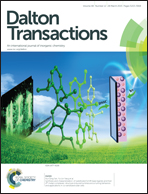Triazolate-based 3D frameworks and a 2D layer with centrosymmetric CuII7, CuII5, CuII4 clusters and tunable interlayer/interchain compactness: hydrothermal syntheses, crystal structures and magnetic properties†
Abstract
Four 1,2,3-triazolate-based coordination polymers (CPs) with varied dimensionality, different nuclearity numbers and core topologies, [Cu4(μ-OH)(μ3-OH)(ta)2(btec)]n (1), {[Cu6(μ3-OH)2(ta)8(tp)]·2.5H2O}n (2), {[Cu5(μ3-OH)2(ta)4(ip)2]·2H2O}n (3) and {[Cu5(μ-OH)2(μ3-OH)2(ta)2(pa)2]·2H2O}n (4) (ta = 1,2,3-triazolate, btec = 1,2,4,5-benzenetetracarboxylate, tp = terephthalate, ip = isophthalate and pa = phthalate), were hydrothermally synthesized by varying the numbers and positions of the carboxylate group appended on the phenyl tether, and structurally and magnetically characterized. The former three entities are three-dimensional (3D) robust frameworks with a (44·62)(411·65)2(413·610·85) topological net containing centrosymmetric CuII7 clusters, square-planar CuII1 cores and tetratopic btec4− linkers for 1, a pillared-layered structure consisting of CuII5 + CuII1-based coplanar layers and ditopic tp2− pillars for 2 as well as a microporous architecture derived from CuII5 clusters and directional ip2− connectors for 3. In contrast, complex 4 exhibits an undulated two-dimensional (2D) layer with alternating CuII4 + CuII1 chains interconnected by anionic pa2− connectors. Crystallographically, the increment of the local nuclearity from CuII4 up to CuII7 in 1–4 benefits greatly from the synergistic co-coordination of the hydroxyl group and the coplanar ta− ligand towards the metal ion, and the interlayer/interchain compactness is significantly tuned by the position isomerism of the dicarboxylate moieties. Due to the antiferromagnetic coupling in the local clusters and the asymmetric superexchange by μ3-ta− mediator, these complexes exhibit different spin ground states (paramagnetic S = 1 and 1/2, ferrimagnetic S = 1/2 as well as spin canting) at low temperatures, which are informative for polynuclear-based magnetic materials.


 Please wait while we load your content...
Please wait while we load your content...